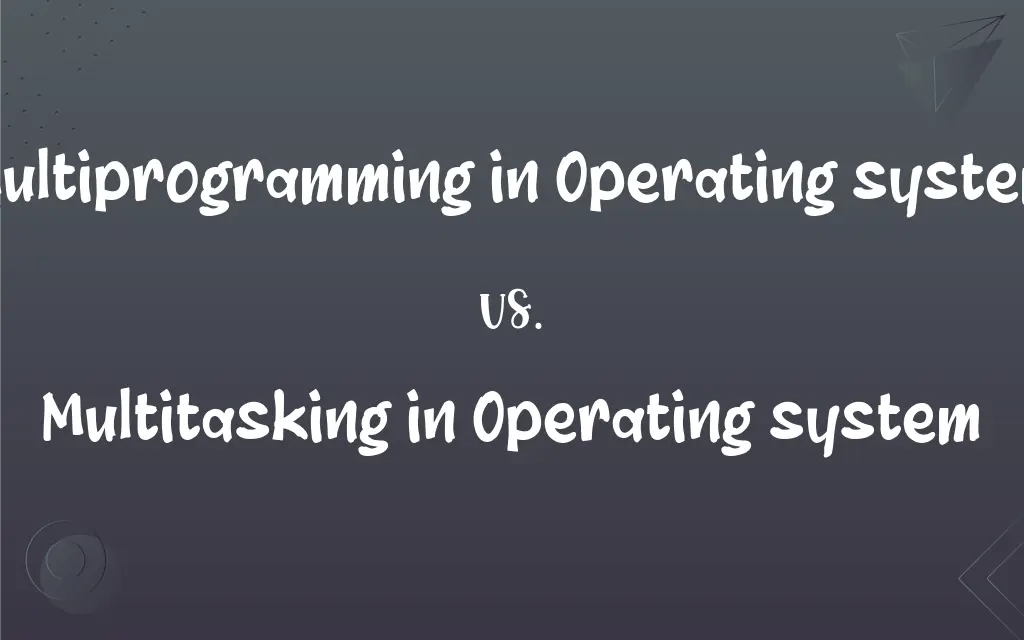Multiprogramming in Operating system vs. Multitasking in Operating system: What's the Difference?
Edited by Aimie Carlson || By Janet White || Published on March 30, 2024
Multiprogramming in OS involves running multiple programs on a single processor by managing their states, while multitasking allows concurrent execution of tasks by rapidly switching between them.

Key Differences
Multiprogramming in an operating system maximizes CPU utilization by running several programs concurrently, keeping multiple programs in memory and switching between them. In contrast, multitasking involves executing multiple tasks or processes at the same time, rapidly alternating between them to give the appearance of simultaneous execution.
In multiprogramming, the operating system selects a job from the job pool and starts executing it; when this job needs to wait (like for I/O operations), the CPU switches to another job. Multitasking, however, involves the operating system dividing CPU time among all the runnable tasks, allocating time slices to each task.
Multiprogramming is primarily about increasing the efficiency of the CPU, reducing idle time by managing multiple programs. Multitasking, on the other hand, is focused on improving the user experience and system responsiveness by allowing several tasks to progress in parallel.
Multiprogramming does not necessarily need advanced CPU scheduling algorithms, as it's more about job management. In contrast, multitasking requires sophisticated scheduling algorithms to manage the time-sharing aspect effectively.
In multiprogramming, a single user cannot run multiple programs simultaneously, whereas multitasking operating systems support multiple users running multiple tasks at the same time.
ADVERTISEMENT
Comparison Chart
Focus
Maximizing CPU utilization by managing programs
Enabling concurrent task execution
Execution Style
Jobs switch upon waiting for resources
Rapid switching between tasks for time-sharing
Primary Goal
Reducing CPU idle time
Enhancing user experience and system responsiveness
Scheduling Complexity
Relatively simple scheduling
Requires sophisticated scheduling algorithms
User Experience
Single-user, non-concurrent program execution
Supports multi-user, concurrent task execution
ADVERTISEMENT
Multiprogramming in Operating system and Multitasking in Operating system Definitions
Multiprogramming in Operating system
Multiprogramming in an OS allows multiple programs to reside in memory simultaneously for efficient CPU utilization.
Through multiprogramming, the OS reduces the idle time of the CPU.
Multitasking in Operating system
Multitasking enhances user experience by allowing several applications to progress concurrently.
Thanks to multitasking, I can download files while browsing the web.
Multiprogramming in Operating system
Multiprogramming enhances system throughput by managing several jobs in the memory.
Multiprogramming increases system throughput by efficiently managing multiple jobs.
Multitasking in Operating system
It involves the rapid switching of the CPU among tasks, giving the illusion of parallelism.
In multitasking, the CPU rapidly switches between tasks for efficient time sharing.
Multiprogramming in Operating system
It's a strategy to keep multiple jobs in memory to keep the CPU as busy as possible.
With multiprogramming, the operating system keeps the CPU busy by managing multiple jobs.
Multitasking in Operating system
This technique relies on advanced CPU scheduling to manage the time-sharing of resources.
Multitasking requires sophisticated CPU scheduling to manage multiple tasks effectively.
Multiprogramming in Operating system
Multiprogramming doesn't allow simultaneous execution of programs, but sequentially manages their execution.
Multiprogramming manages program execution sequentially, not simultaneously.
Multitasking in Operating system
Multitasking supports multi-user environments, allowing different users to run tasks simultaneously.
In a multitasking OS, multiple users can perform different tasks at the same time.
Multiprogramming in Operating system
It involves switching the CPU among programs when one program is stalled, especially during I/O operations.
The OS switches to another program when one is waiting for I/O in multiprogramming.
Multitasking in Operating system
Multitasking in an OS enables the simultaneous execution of multiple tasks by dividing CPU time.
Multitasking allows a user to edit a document while a video is playing.
FAQs
What is multiprogramming in an OS?
It's a method where multiple programs are kept in memory and managed for efficient CPU usage.
What is multitasking in an OS?
Multitasking is the ability of an OS to execute multiple tasks concurrently by sharing CPU time.
How does multitasking manage CPU time?
By dividing CPU time among tasks via time-sharing.
How does multitasking enhance user experience?
By allowing simultaneous progress of multiple tasks, improving system responsiveness.
Can multitasking handle multiple users?
Yes, it supports multi-user environments.
How does multiprogramming increase CPU efficiency?
By reducing idle time, as the CPU switches to another program when one is waiting for I/O.
Is multiprogramming suitable for multi-user systems?
No, it's more focused on single-user systems.
How does multitasking affect system throughput?
It can increase throughput by efficiently managing task execution.
Does multiprogramming allow real-time task execution?
Not really, as it doesn’t focus on simultaneous execution.
Can multiprogramming run interactive tasks efficiently?
It's less efficient for interactive tasks compared to multitasking.
Does multiprogramming support concurrent program execution?
It manages programs in memory but doesn't execute them concurrently.
Can multiprogramming lead to resource underutilization?
It's less likely, as it aims to keep the CPU busy.
How does multitasking handle I/O-bound and CPU-bound tasks?
It efficiently manages these tasks by allocating appropriate CPU time to each.
Are there any drawbacks to multiprogramming?
It can be less efficient for systems requiring high interactivity.
Does multitasking require more system resources?
Yes, it requires more resources for managing multiple concurrent tasks.
What kind of scheduling is used in multiprogramming?
Relatively simpler job scheduling is used.
What kind of scheduling is required for multitasking?
It requires sophisticated, time-sharing scheduling algorithms.
Is multitasking suitable for interactive systems?
Yes, it's ideal for interactive systems.
What are the challenges in implementing multitasking?
Ensuring efficient task scheduling and managing the overhead of context switching.
Is multitasking more complex than multiprogramming?
Yes, due to its need for rapid task switching and time-sharing management.
About Author
Written by
Janet WhiteJanet White has been an esteemed writer and blogger for Difference Wiki. Holding a Master's degree in Science and Medical Journalism from the prestigious Boston University, she has consistently demonstrated her expertise and passion for her field. When she's not immersed in her work, Janet relishes her time exercising, delving into a good book, and cherishing moments with friends and family.
Edited by
Aimie CarlsonAimie Carlson, holding a master's degree in English literature, is a fervent English language enthusiast. She lends her writing talents to Difference Wiki, a prominent website that specializes in comparisons, offering readers insightful analyses that both captivate and inform.
































































